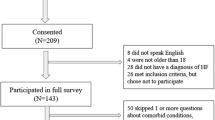Abstract
There is a gap in the literature about psychological status of patients following penile fracture surgery. We aimed to assess the long-term psychological status of penile fracture patients who have been treated by immediate surgical repair. A total of 32 patients with penile fracture have been treated surgically at our center. These 32 patients and 30 healthy control subjects were included in the study. All participants have completed the Hospital Anxiety and Depression Scale (HADS), Glombok-Rust Inventory of Satisfaction Scale (GRISS), and the premature ejaculation diagnostic tool (PEDT). The mean age of patients was 30.4 years and the mean body mass index was 27.3 kg m−2. Sexual intercourse was the most common cause of the fracture. Immediate surgical repair was performed in all cases using a circumferential subcoronal incision and none of the patients had urethral injury intraoperatively. All tears were unilateral with a mean size of 1.5 cm. Only two patients had superficial dorsal vein rupture. At the day of assessment, the mean time elapsed after penile trauma was 15.9±6.3 months (range: 6–23). Only three patients had complications due to penile fracture including minimal penile curvature, penile nodule, and penile pain during intercourse. The mean scores obtained from PEDT, HADS, and GRISS did not show any statistically significant difference between groups. Anxiety, depression, premature ejaculation, and sexual dyssatisfaction levels were similar in both penile fracture patients who underwent immediate surgical repair and healthy control subjects. Immediate surgical repair of corporal ruptures have not shown any harmful psychogenic sequelae on patients with penile fracture.
This is a preview of subscription content, access via your institution
Access options
Subscribe to this journal
Receive 8 print issues and online access
$259.00 per year
only $32.38 per issue
Buy this article
- Purchase on Springer Link
- Instant access to full article PDF
Prices may be subject to local taxes which are calculated during checkout
Similar content being viewed by others
References
Haas CA, Brown SL, Spirnak JP . Penile fracture and testicular rupture. World J Urol 1999; 17: 101–106.
Jordan GH, Gilbert DA . Male genital trauma. Clin Plast Surg 1988; 15: 431–442.
Miller S, McAninch JW . Penile fracture and soft tissue injury. In: McAninch JW (ed). Traumatic and Reconstructive Urology. Philadelphia: WB Saunders, 1996, pp 693–698.
Eke N . Fracture of the penis. Br J Surg 2002; 89: 555–565.
Ibrahiem el-HI, el-Tholoth HS, Mohsen T, Hekal IA, el-Assmy A . Penile fracture: long-term outcome of immediate surgical intervention. Urology 2010; 75: 108–111.
Koifman L, Barros R, Júnior RA, Cavalcanti AG, Favorito LA . Penile fracture: diagnosis, treatment and outcomes of 150 patients. Urology 2010; 76: 1488–1492.
Hsu GL, Hsieh CH, Wen HS, Kang TJ, Chiang HS . Curvature correction in patients with tunical rupture: a necessary adjunct to repair. J Urol 2002; 167: 1381–1383.
Nicoliasen GS, Melamud A, McAninch JW . Rupture of the corpus cavernosum: surgical management. J Urol 1983; 130: 917–919.
Thompson RF . Rupture (fracture) of the penis. J Urol 1954; 71: 226–229.
Yapanoglu T, Aksoy Y, Adanur S, Kabadayi B, Ozturk G, Ozbey I . Seventeen years’ experience of penile fracture: conservative vs. surgical treatment. J Sex Med 2009; 6: 2058–2063.
Mydlo JH, Hayyeri M, Macchia RJ . Urethrography and cavernosography imaging in a small series of penile fractures: a comparison with surgical findings. Urology 1998; 51: 616–619.
Jack GS, Garraway I, Reznichek R, Rajfer J . Current treatment options for penile fractures. Rev Urol 2004; 6: 114–120.
Serefoglu EC, Cimen HI, Ozdemir AT, Symonds T, Berktas M, Balbay MD . Turkish validation of the premature ejaculation diagnostic tool and its association with intravaginal ejaculatory latency time. Int J Impot Res 2009; 21: 139–144.
Zigmond AS, Snaith RP . The hospital anxiety and depression scale. Acta Psychiatr Scand 1983; 67: 361–370.
Aydemir O . Validity and reliability of Turkish version of hospital anxiety and depression scale. Turk Psikiyatri Derg 1997; 8: 280–287.
Rust J, Golombok S . The GRISS: a psychometric instrument for the assessment of sexual dysfunction. Arch Sex Behav 1986; 15: 157–165.
Tugrul C, Oztan N, Kabakci E . Standardization of Golombok-Rust inventory of sexual satisfaction. Turk Psikiyatri Dergisi 1993; 4: 83–88.
Penson DF, Seftel AD, Krane RJ, Frohrib D, Goldstein I . The hemodynamic pathophysiology of impotence following blunt trauma to the erect penis. J Urol 1992; 148: 1171–1180.
Zargooshi J . Penile fracture in Kermanshah, Iran: report of 172 cases. J Urol 2000; 164: 364–366.
Zargooshi J . Sexual function and tunica albuginea wound healing following penile fracture: an 18-year follow-up study of 352 patients from Kermanshah, Iran. J Sex Med 2009; 6: 1141–1150.
Fergany AF, Angermeier KW, Montague DK . Review of Cleveland Clinic experience with penile fracture. Urology 1999; 54: 352–355.
Author information
Authors and Affiliations
Corresponding author
Ethics declarations
Competing interests
The authors declare no conflict of interest.
Rights and permissions
About this article
Cite this article
Penbegul, N., Bez, Y., Atar, M. et al. No evidence of depression, anxiety, and sexual dysfunction following penile fracture. Int J Impot Res 24, 26–30 (2012). https://doi.org/10.1038/ijir.2011.42
Received:
Revised:
Accepted:
Published:
Issue Date:
DOI: https://doi.org/10.1038/ijir.2011.42
Keywords
This article is cited by
-
Older age and a large tunical tear may be predictors of increased erectile dysfunction rates following penile fracture surgery
International Journal of Impotence Research (2020)
-
Surgical reconstruction for penile fracture: a systematic review
International Journal of Impotence Research (2020)
-
Effects of penile fracture and its surgical treatment on psychosocial and sexual function
International Journal of Impotence Research (2017)



